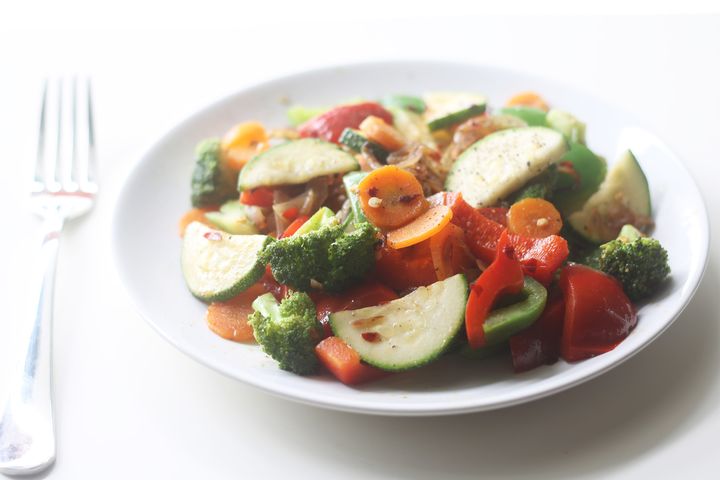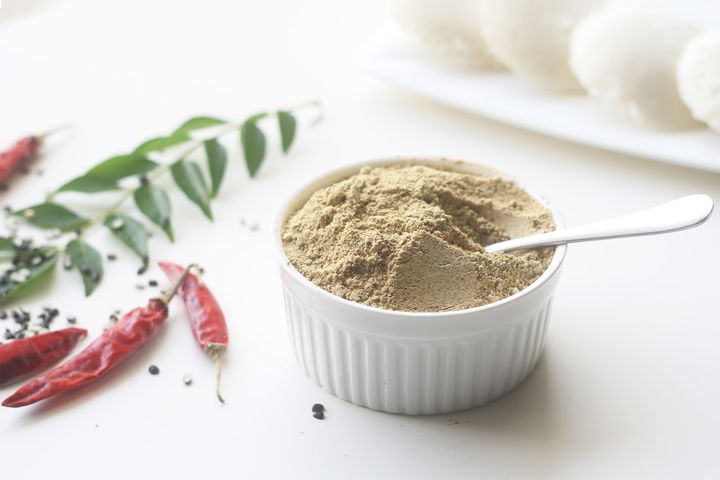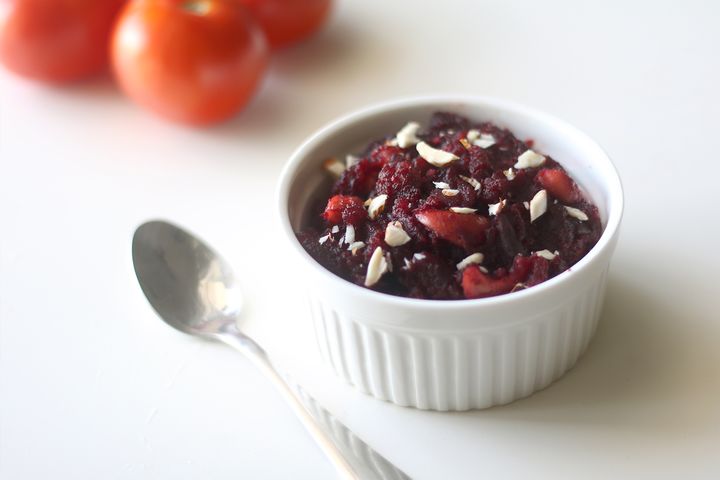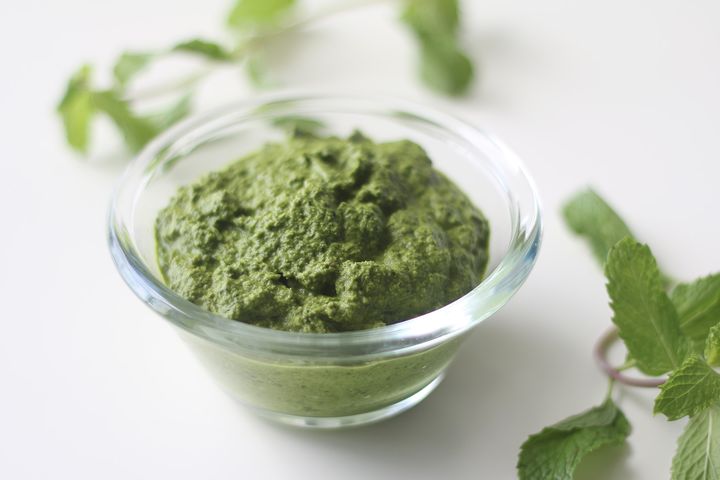Mango Pachadi
Mango Pachadi is a traditional South Indian dish that combines the tangy flavor of raw mangoes with the sweetness of palm jaggery.
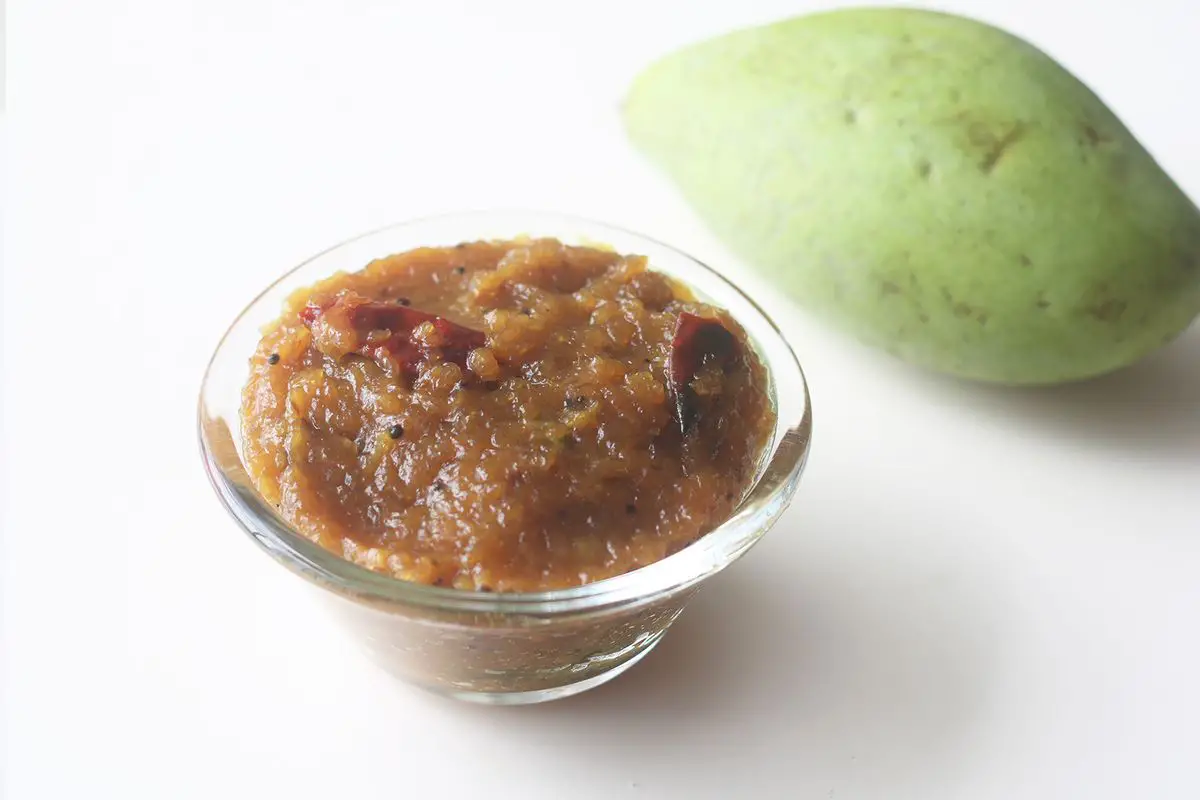
Mango pachadi is a traditional South Indian recipe that is both sweet and tangy, making it a popular dish during festive occasions. This delicious dish is made with raw mango, jaggery, and a blend of aromatic spices, creating a unique flavor profile that will leave your taste buds wanting more. In this article, we will walk you through the steps to make this delectable mango pachadi at home. Get ready to indulge in the flavors of South India with this delightful recipe.
What Is Mango Pachadi?
- Mango Pachadi is a traditional South Indian dish that combines the tangy flavor of raw mangoes with the sweetness of palm jaggery. This delicious dish is seasoned with Indian spices like mustard seeds, urad dal, cumin seeds, and curry leaves, giving it a unique and delightful flavor profile.
- The succulent grated mangoes are cooked with the perfect blend of spices and jaggery, creating a sweet and tangy chutney-like dish that is perfect as a side or a condiment. The addition of cardamom powder adds a beautiful aromatic touch to the pachadi, making it a flavorful accompaniment to any South Indian meal.
Why You'll Love Mango Pachadi?
- Deliciously Textured: Mango pachadi has a unique texture that combines the tanginess of the mango with the sweetness of jaggery, creating a delightful flavor experience in every bite.
- Health Benefits: The raw mango used in this recipe is a good source of Vitamin C and other antioxidants, which can help boost immunity and promote overall health.
- Balanced Flavors: The combination of sweet, sour, and savory flavors in mango pachadi makes it a perfectly balanced dish that pleases the palate.
- Versatile Dish: Mango pachadi can be served as a side dish for rice or roti, or even enjoyed on its own as a sweet and tangy snack.
- Traditional Recipe: This recipe has been passed down through generations, making it a beloved part of Indian culinary traditions.
- Easy to Make: With simple ingredients and easy-to-follow instructions, mango pachadi is a dish that anyone can prepare and enjoy.
Ingredients for Mango Pachadi
Firstly, for this delicious mango pachadi recipe, the key ingredients are:
- Raw Mango: The raw mango adds a tangy and sour flavor to the pachadi, balancing the sweetness of the jaggery.
- Palm Jaggery: The palm jaggery adds a natural sweetness and rich caramel-like flavor to the pachadi.
- Salt: The salt enhances the overall flavors and balances the sweetness of the dish.
- Turmeric Powder: The turmeric powder adds a vibrant color and subtle earthy flavor to the pachadi.
- Ghee: The ghee is used for tempering and adds a rich and nutty aroma to the dish.
- Cardamom Powder: The cardamom powder adds a warm and aromatic flavor to the pachadi, enhancing its overall taste.
How To Make Mango Pachadi?
Mango pachadi is a delightful South Indian dish that combines the tanginess of raw mangoes with the sweetness of jaggery. Follow these simple steps to create this delicious recipe:
- Start by washing and peeling the skin of the mangoes. Then grate the mangoes and set them aside.
- Powder the jaggery and keep it aside as well.
- Heat a pan with oil over medium heat and add mustard seeds, urad dal, and cumin seeds. Fry until they start spluttering.
- Add red chillies and curry leaves and fry for a few seconds.
- Add the grated mangoes, salt, and turmeric powder, and stir-fry for 2 minutes.
- Pour in 3/4 cup of water, mix well, cover, and cook for 4 to 5 minutes over low heat until the mango is cooked through.
- Add the powdered jaggery, mix well, and cook over medium heat until it becomes slightly thick.
- Add 1 tsp ghee and sauté well.
- Finally, add cardamom powder, the remaining 1 tsp ghee, mix well, and switch off the heat.
Each step in this process is crucial for achieving the perfect balance of flavors in the mango pachadi. From preparing the mangoes and jaggery to the precise cooking times and adding key spices, following these instructions will ensure a flavorful and delicious mango pachadi.

Serving Suggestions
- Pair with Rice: Mango pachadi goes well with steamed white rice or even coconut rice. The tangy and sweet flavors of the pachadi complement the plain rice perfectly.
- Accompany with Roti or Naan: For a more diverse meal, pair the mango pachadi with some Indian bread like roti or naan. The combination of the soft bread and the flavorful pachadi is simply delightful.
- Serve with Curd Rice: Another great option is to serve the pachadi with some soothing curd rice. The creamy texture of the curd rice balances the tanginess of the mango pachadi.
- Side with Pappadums: Crispy pappadums make for an excellent side dish to accompany the mango pachadi. The crunchy texture of the pappadums complements the soft and tangy pachadi.
- Enjoy with Vegetable Sambar: For a complete South Indian meal, pair the mango pachadi with some warm and comforting vegetable sambar. The combination of flavors and textures is sure to satisfy your taste buds.
- Include a Fresh Salad: Add a refreshing side of cucumber and carrot salad to balance out the meal. The crunch of the salad pairs well with the rich and flavorful pachadi.
Tips for Making Mango Pachadi
- Preparation Duration: Grating the mango and powdering the jaggery may take about 10-15 minutes, while the cooking process itself takes around 10-15 minutes.
- Cooking Techniques: To ensure the mango pachadi is cooked through, cover and cook over low heat for 4-5 minutes after adding water. Additionally, when adding the powdered jaggery, cook over medium heat until it becomes slightly thick for the perfect consistency.
- Garnishing for Presentation: Garnishing with a sprinkle of cardamom powder and a drizzle of ghee not only enhances the flavor but also adds a beautiful touch for presentation.
- Balancing Flavors: Adjust the amount of palm jaggery according to your taste preference for a perfect balance of sweetness and tanginess.
- Consistency Check: Before switching off the heat, ensure that the pachadi has reached a slightly thick consistency, which is essential for the overall texture and taste.
- Serving Suggestion: Mango pachadi pairs well with steamed rice and is best enjoyed when served fresh. Consider serving it as a side dish or a condiment alongside your favorite Indian meal.
Variations for Mango Pachadi
- Sweetness Level: Adjust the amount of palm jaggery to suit your taste. If you prefer a sweeter pachadi, add more jaggery, and for a less sweet version, reduce the amount.
- Spice Level: Experiment with the amount of red chillies to control the spice level. You can also try using different types of chillies for a unique flavor.
- Texture: For a chunkier texture, you can cut the mangoes into small pieces instead of grating them. This will add a different mouthfeel to the dish.
- Nutty Flavor: Add a handful of roasted peanuts or cashews for a crunchy and nutty element to the pachadi.
- Fresh Herbs: Garnish the pachadi with fresh cilantro or mint to add a burst of freshness to the dish.
- Coconut Twist: For a creamy twist, add a few tablespoons of grated coconut to the pachadi for a rich and indulgent flavor.
By experimenting with these variations, you can create a unique and personalized mango pachadi that suits your taste preferences. Enjoy the process of discovering new flavors and combinations!
How to Store Mango Pachadi
- Refrigeration: After preparing the mango pachadi, store it in an airtight container in the refrigerator. This will help to maintain its freshness and flavors for a longer period of time.
- Use Fresh Ingredients: It is important to use fresh raw mango and jaggery when making mango pachadi. Fresh ingredients will ensure the dish stays flavorful and delicious for a longer time.
- Proper Seal: Ensure that the container used for storing the mango pachadi is properly sealed to prevent any air from entering, which can cause the dish to spoil faster.
- Avoid Moisture: Keep the mango pachadi away from moisture, as it can cause the dish to spoil quickly. Store it in a dry and cool place.
- Consume Within a Week: While mango pachadi can be stored, it is best to consume it within a week of preparing it to enjoy its best flavors.
- Reheating: When reheating the mango pachadi, ensure that it is heated thoroughly before consuming to maintain its taste and texture.
Frequently Asked Questions (FAQs)
How can I adjust the sweetness of mango pachadi?
- You can adjust the sweetness of the pachadi by adding more or less palm jaggery according to your taste preferences. Start with the recommended amount and then adjust to taste.
Can I use ripe mangoes for this recipe?
- For the traditional mango pachadi, it is best to use raw mangoes as they provide a tangy flavor. Ripe mangoes will result in a different taste and texture.
What is the purpose of adding turmeric powder?
- Turmeric powder is added for color and a subtle flavor. It also enhances the overall visual appeal of the dish.
Can I refrigerate mango pachadi?
- Yes, you can store the leftover mango pachadi in an airtight container in the refrigerator for a few days. Just reheat before serving.
What are some serving suggestions for mango pachadi?
- Mango pachadi can be served as a side dish with steamed rice, dosa, or idli. It can also be enjoyed on its own as a sweet and tangy dessert.
Can I skip adding ghee to the pachadi?
- Ghee adds a rich flavor to the pachadi, but if you prefer to avoid it, you can omit it from the recipe. However, it may alter the final taste slightly.
Recipe Card
Mango Pachadi 2021-05-09 02:51:55
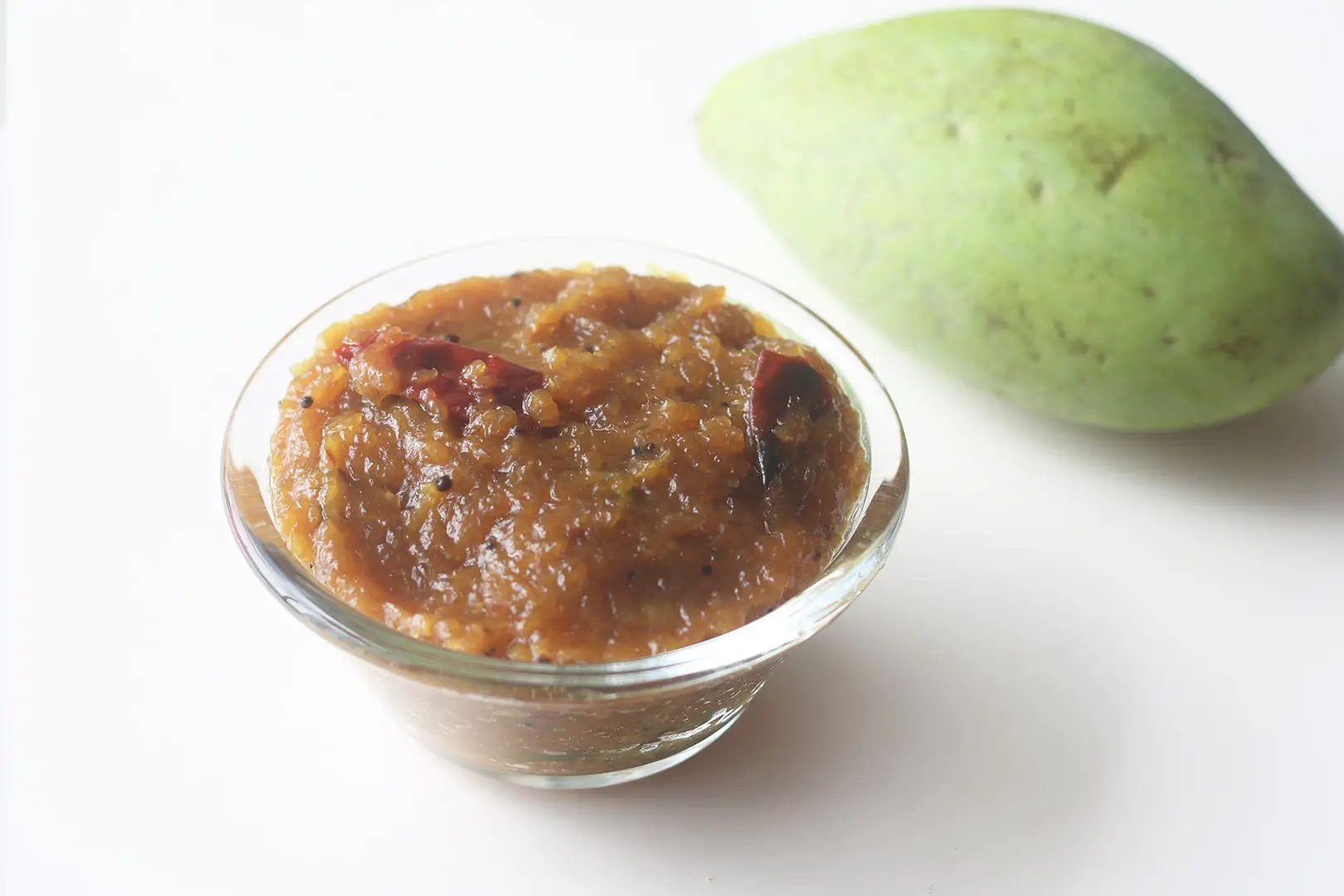
Mango Pachadi
Serves 4
Prep Time: 00:10
Cook Time: 00:15
Total Time: 00:25
Ingredients
- 1 large sized raw mango
- 1/2 cup or to taste Palm jaggery
- less than 1/4 tsp Salt
- 1/8 tsp Turmeric powder
- 2 tsp Ghee
- 1/4 tsp cardamom powder
- 1/2 tbsp Sesame oil
- 1 tsp Mustard and urad dal
- 1/2 tsp Cumin seeds
- 2 to 3 Red chillies
- Few curry leaves
Instructions
- Firstly, wash and peel the skin of the mangoes. Then grate the mangoes and keep it aside.
- Then powder the jaggery and keep it aside.
- Meanwhile, heat a pan with oil over medium heat.
- When the oil heats, add mustard seeds, urad dal and cumin seeds and fry until spluttering.
- Then add red chillies and curry leaves, fry for few seconds.
- Further, add grated mangoes and mix well.
- Then add salt and turmeric powder, stir fry for 2 mins.
- Then add 3/4 cup of water, mix well.
- Cover and cook for 4 to 5 mins until it is cooked through, over low heat.
- Then add powdered jaggery, mix well.
- Cook over medium heat until it becomes slightly thick.
- Now add 1 tsp ghee and saute well.
- Finally, add cardamom powder, and the remaining 1 tsp ghee mix well and switch off the heat.
- Now tasty mango pachadi is ready to serve.
By Santhi Therese
The Indian Claypot
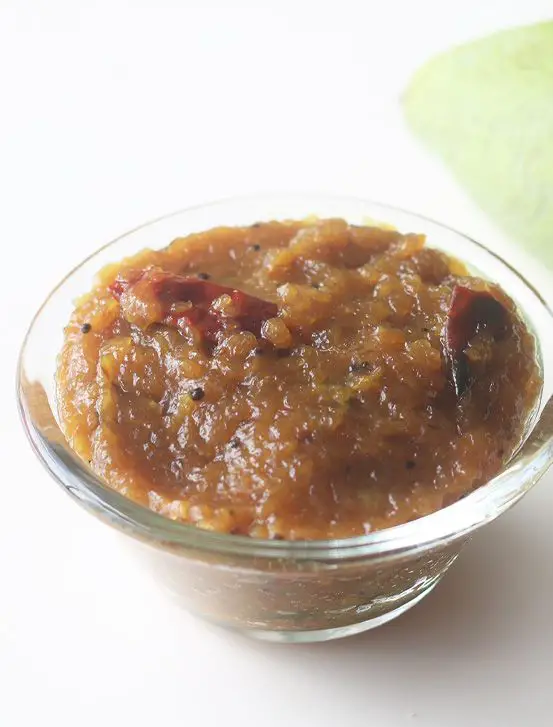
Step-By-Step Instructions:
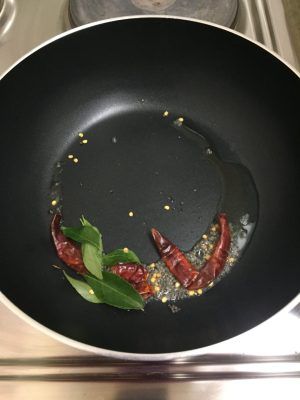
heat a pan with oil over medium heat. When the oil heats, add mustard seeds, urad dal, cumin seeds and fry until spluttering. Then add red chilies and curry leaves, fry for few seconds.
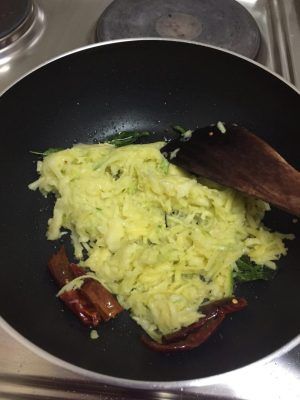
Further, add grated mangoes and mix well.
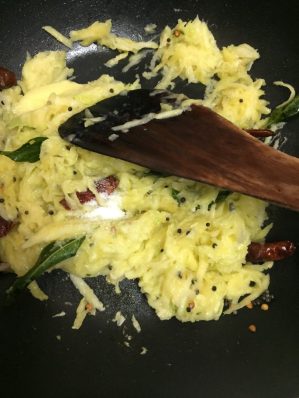
Then add salt and turmeric powder, and stir-fry for 2 mins.
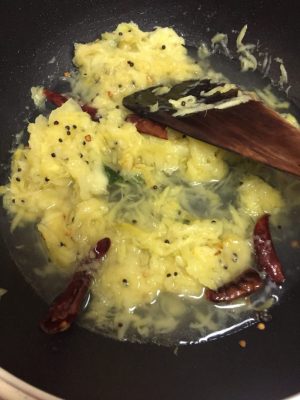
Then add 3/4 cup of water, mix well.
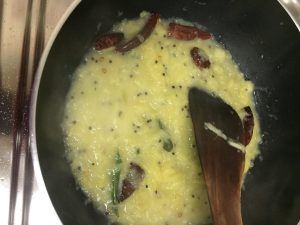
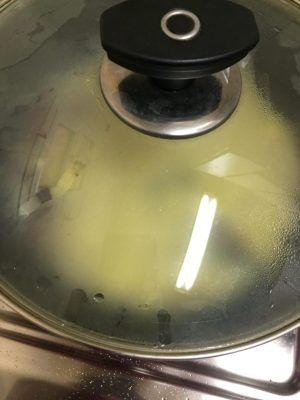
Cover and cook for 4 to 5 mins until it is cooked through, over low heat.
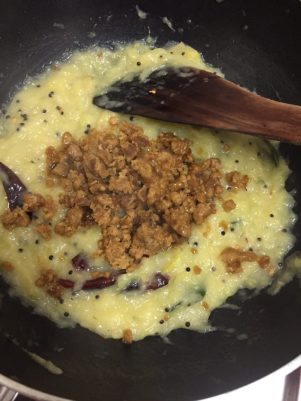
Then add powdered jaggery, mix well.
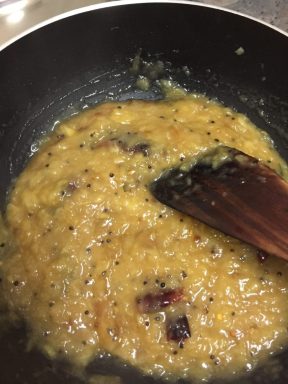
Cook over medium heat until it becomes slightly thick.
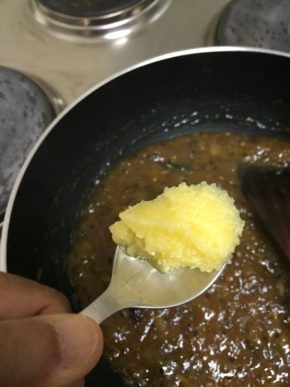
Now add ghee and saute well.
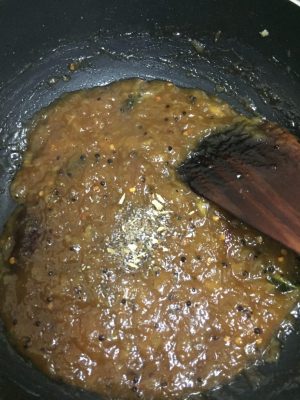
Finally, add cardamom powder, mix well and switch off the heat.
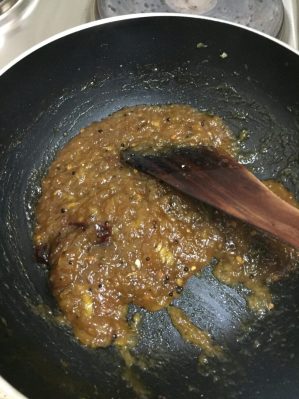
Now tasty mango pachadi is ready to serve.
You may also like my other side dishes posts and recipes like Easy Stir Fry Vegetable Recipe, Idli Podi Recipe, Tomato Pachadi, Pudina Chutney, South Indian Coconut Chutney, Vazhaithandu Poriyal, Avial Recipe, Mango Pachadi .
